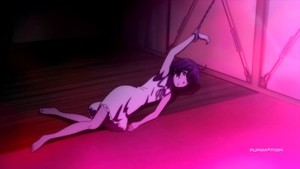Ranpo Kitan: Game of Laplace
Episodes 1-3
by Rebecca Silverman,
How would you rate episode 1 of
Rampo Kitan: Game of Laplace ?
Community score: 3.5
How would you rate episode 2 of
Rampo Kitan: Game of Laplace ?
Community score: 3.3
How would you rate episode 3 of
Rampo Kitan: Game of Laplace ?
Community score: 3.4

From the young lady detectives of Anna Katherine Greene to Nancy Drew to the Scooby Gang, young detectives have been around almost as long as detective fiction has officially been a genre. This was hardly an American phenomenon, despite the fact that I just listed three such examples; where ever mystery stories were being penned, youthful detectives seemed to appear. Japan was no exception, and the celebrated Japanese mystery author Rampo Edogawa (say his name family name first and it sounds a bit like “Edgar Allen Poe”) had his own special group of young investigators, headed by Akechi Kogoro. These boy detectives featured in many stories, solving crime after crime, and now, fifty years after Edogawa's death, his most famous creation is reimagined in the show Rampo Kitan: Game of Laplace. Unfortunately these first three episodes don't quite translate as well as they might have, offering some interesting bones for seasoned mystery buffs but using other tricks which don't work quite as well.
These episodes cover two cases, both adapted from Edogawa's short stories. (While many of his stories are available in English translation, they've been repackaged, so the titles of the collections don't match up; thus I can't say with any certainty that these stories are available...) The first two episodes are “The Human Chair,” which serve as an introduction to both the characters and the way the show will present the investigations; the third is a stand-alone mystery called “The Shadow Man.” “The Human Chair” looks into the death of a middle school teacher with some pretty twisted hobbies: he turns the women he loves into furniture so that he can forever sit upon their laps and recline between their breasts. While the show doesn't make as big a deal out of these factors as it could, that actually works in its favor here, letting the visuals handle the creep factor. It helps that our protagonist, thirteen-year-old Kobayashi, is kind of off himself – he's bored with his life and sees being accused of his teacher's murder as a way to really live. Honestly, I find him much more disturbing than the love-crazed murderer as he sweetly smiles his way through the episodes and examines gruesome clues with a beatific look upon his face. He also may be the reason behind the fact that only “important” characters are seen fully realized – in the first episode we see the new (inappropriately dressed) teacher appear before our eyes as she finally piques Kobayashi's interest. (In the third episode, the argument could be made at the end that we don't see a character because Kobayashi wants him to be unimportant.) In any event, his portrayal is one of the more effective tricks the show uses.
On the less useful side we have the way that Rampo Kitan plays out many scenes as if they were a stage play. This presumably is supposed to function as a stand-in for lengthy info dumps; we understand that Kobayashi's the one actually explaining things to either his friend Hashiba or the police, but we see it play out, more or less Ellery Queen-style. It's really a bit overdone, making things more melodramatic than they need to be and taking away from some of the shock value, as well as simply making the mystery too easy. Not that these mysteries necessarily follow the Knox's Commandments to a T. The most broken one would be six, where the detective isn't allowed super-powerful intuition, although when you really go back and analyze the cases, they do stick relatively close in many cases. It isn't, however, all that possible to solve the case before or alongside the detective, which may be the biggest deterrent to mystery fans.
Episode three feels stronger than the first two, possibly because with everyone introduced there's more time to focus on the mystery itself. (Though I'd argue that the villain is a contemporary Japanese version of breaking rule 5, which is about stereotypical bad guys.) In some ways it's also a more brutal story, despite the fact that less physical violence is committed, and the sadness when you find out the truth of the matter is effective, if not a bit cliché. There are some very interesting animation techniques used throughout all three episodes, involving color, placement on the screen, and quick cut-aways, and the ending theme is really visually fascinating. Background music can get a little too goofy, but both theme songs are strong and the voices work as well.
With its nods to other detectives in fiction (this Akechi seems to have a pill habit; Kobayashi's cross-dressing skill is original to his character in Edogawa's stories) and updates of Edogawa's work for a modern viewership, Rampo Kitan: Game of Laplace is really trying to provide an entertaining mystery experience. It gets closer in the third episode, but there's really not much here otherwise that feels particularly exciting or fresh in the genre, whether we're talking about mysteries within anime or in general. It's not worth writing off yet, but thus far Noitamina's ode to Edogawa is just so-so. I don't dread its return next week (except that medical examiner and Corpsey – they were annoying), but I'm also not looking forward to it with baited breath.
Rating: C
Ranpo Kitan: Game of Laplace is currently streaming on Funimation.
discuss this in the forum (73 posts) |
back to Ranpo Kitan: Game of Laplace
Episode Review homepage / archives